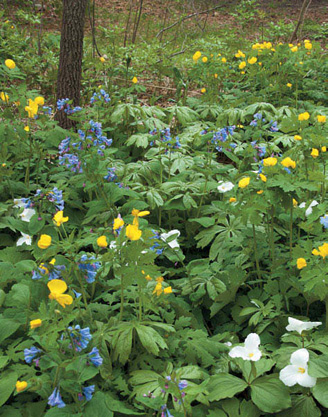
(Clockwise from top left) Woodland ephemerals include white stars on foamflower spikes (Tiarella cordifolia) among fern crosiers, hooded green Jack-in-the-pulpits (Arisaema triphyllum), yellow trout lilies named for their mottled foliage (Erythronium americanum), white European wood anemone (Anemone nemerosa), foamflower’s maple-shaped leaves.

Wherever there is soil and ample rainfall, there are trees. Wherever there are trees, they are in danger. “Any fool can destroy trees,” wrote the great naturalist John Muir. “They cannot run away; and if they could, they would still be destroyed— chased and hunted down as long as fun or a dollar could be got out of [them].”
The ancient American forests include the coastal conifer stands of the Northwest, the oak woodlands of California and Texas, the pine woods of the South, and the wooded Appalachian mountain range. My garden lies in the coastal northeastern forests, an area that encompasses the Appalachian Piedmont and coastal plain through seven states from Maryland to southwestern Maine. It is a broadleaf, temperate mixed-hardwood forest characterized by maple, oak, beech, wild cherry, black walnut, hickory, tulip poplar, ash, birch, white pine, and hemlock.
Most of the old-growth woodland has been lost to development. We can replant trees, but cannot bring back the ecosystem they defined. The woods surrounding my property have grown up in the years since this land was last farmed as apple orchards. The understory plants had made a comeback, but have all but disappeared due to browsing deer and, most recently, invasive weeds. Old government surveys of wild areas can often be found at the library, noting genera and species like Trillium spp., Phlox divaricata, foamflower (Tiarella spp.), Cypripedium slipper orchids, Arisaema triphyllum (Jack-in-the-pulpit), Carex spp., columbine (Aquilegia canadensis), bloodroot (Sanguinaria canadensis), wild ginger (Asarum spp.), Erythronium spp., mayapple (Podophyllum peltatum), Iris, Virginia bluebells (Mertensia virginica), wood poppy (Stylophorum diphyllum), and a dozen fern species.
I’ve grown many of these plants. None were wild-collected. I grew some from seeds; others were purchased from nearby public wildflower garden fund-raisers and nurseries specializing in propagating local plants. I have a few woodland beds where I tend these plants in the soil beneath a huge white pine to try and preserve their genes while enjoying their remarkable beauty.
The word soil as I use it here is not quite accurate; the growing medium is not like garden loam. It’s more like the natural “duff” found on the forest floor—humus made of decomposing vegetable matter. Just a few inches deep, the duff becomes quite dry in summer, which is another reason many of these plants, which come up and bloom early in the rainy spring, go semi-dormant or completely disappear by the first days of summer.
My woodland garden with white trillium, Virginia bluebells, yellow wood poppy and Mayapple leaves.
